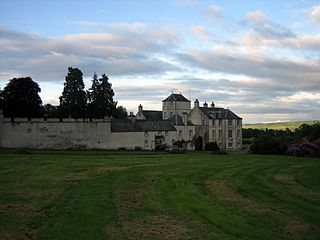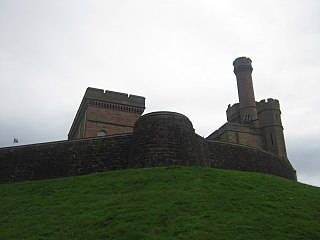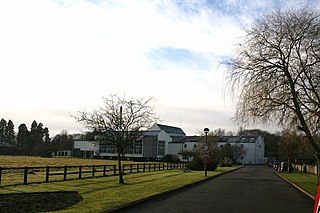

Teaninich Castle is situated north of the village of Evanton and just south of the town of Alness in Ross and Cromarty, Scotland.


Teaninich Castle is situated north of the village of Evanton and just south of the town of Alness in Ross and Cromarty, Scotland.
It is not known exactly how long a castle has been on the site of Teaninich Castle but it is thought to date back to at least the 16th century. In the 16th century, the lands in which Teaninich Castle is situated was an area known as Fyrish. In 1589, the lower quarter of the Fyrish lands were acquired from Sir William Keith of Delny by Hugh Munro 1st of Teaninich, son of John Munro 3rd of Coul, whose grandfather Hugh Munro 1st of Coul was a son of George Munro, 10th Baron of Foulis (d.1452). These lands at first were just the lower quarter of Fyrish but eventually extended eastward towards the River Alness and Teaninich Castle was bought by the Munros in February 1660. The receipt for which is still preserved in the Teaninich Charter Chest.
Two worn lintel stones dated 1734 and 1770 built into the rear of the present castle cum mansion suggest an earlier building of some size and style. Part of the old Teaninich Castle was pulled down by Hugh Munro of Teaninich, 78th Highlanders, who lost the sight in both of his eyes in Nijmegen, the Netherlands in 1794.
However, later, he occupied himself with improving his farmlands and rebuilding Teaninich Castle. The Blind Captain or blind laird, as he became known, took an enthusiastic interest in the supervision of the building of the present Teaninich Castle, often pacing out the room sizes himself. The asymmetry of the rooms is proof of his "enthusiasm".
He founded the Teaninich distillery on the estate in 1817 and laid out the village of Alness at a time when illegal whisky gave the best return on the barley crops of Ross-shire. In 1831, Hugh Munro sold the castle to his brother General John Munro, 9th of Teaninich and spent the remainder of his life in Coul Cottage, the dower house of Teaninich. He died in 1846. The castle remained in the Munro family until 1923. [1] Teaninich remained a Munro seat until after the First World War when it was bought by an American, Charles Harrison, the man on whom Frances Hodgson Burnett's book 'Little Lord Fauntleroy' was based. He is best remembered for the large American car he drove. [2]
In the present day the castle has become a hotel. In 2007 Teaninich House sold off 10 acres (4.0 ha) of paddock land immediately behind the house onto which a property developer is currently building 36 houses. Further developments are expected, potentially involving the selling off and cutting down of the remaining woodland to the rear and northeast border of the house and garden ground, thus bringing the already extensive housing estate closer to the property.[ citation needed ]
As of August 2013 the property was being offered for sale, by agents CKD Galbraith, for £875,000. [3] In 2016 estate agents Galbraith were marketing the castle again for £450,000 [4] [5]

Clan Ross is a Highland Scottish clan. The original chiefs of the clan were the original Earls of Ross.

Alness is a town and civil parish in Ross and Cromarty, Scotland. It lies near the mouth of the River Averon, near the Cromarty Firth, with the town of Invergordon 3 miles (5 km) to the east, and the village of Evanton 4 miles (6 km) to the south-west. The parish has a population of 5,310, although the census locality, which includes part of the parish of Rosskeen, has a population of 5,186.

Foulis Castle is situated two miles south-west of Evanton in the parish of Kiltearn, Ross and Cromarty, Scotland. It is a white washed mansion that incorporates an old tower house with gun loops. The castle was held by the Clan Munro from the twelfth century or earlier and they had a stronghold there.

Castle Chanonry of Ross, also known as Seaforth Castle, was located in the town of Fortrose, to the north-east of Inverness, on the peninsula known as the Black Isle, Highland, Scotland. Nothing now remains of the castle. The castle was also known as Canonry or Chanonrie of Ross, the former county.

Balconie Castle lay in the parish of Kiltearn, about 1⁄2 mile east of the village of Evanton in the Highlands of Scotland.

The Monro of Fyrish family were a Scottish family and branch of the ancient highland Clan Munro. The family produced a notable dynasty of doctors to London in the 18th and 19th century where they were involved in early work on curing 'insanity'. Four generations occupied successively the position of (Principal) Physician of the notorious Bethlem Hospital (Bedlam). They were also leading members of a variety of important medical associations. Other members were painters, priests and philanthropists of note and one was an important early patron to J. M. W. Turner.

Novar House is an 18th-century building, located 0.7 miles north of the village of Evanton in Ross, Scotland. It is built on the site of an earlier castle.

Fyrish is the name given to an ancient area of land found just north of Evanton, Ross-shire, Scotland.
The Munros of Milntown were a family cadet branch of the Highland Clan Munro. As the earliest recorded cadet branch of the Munro chiefs, the Munros of Milntown were the 'senior' cadet branch of the clan, and spawned many cadet branches. They were frequently recorded as 'Monro' as well as Munro. The Munros of Milntown are notable for being involved in events concerning the history of the late Middle Ages in the Scottish Highlands.
Sir Robert Munro, 5th Baronet of Foulis was also 23rd Baron and 26th chief of the Clan Munro. He became blind and was known as the Blind Baron.
Robert Mor Munro, 15th Baron of Foulis, and 18th chief of the Clan Munro was a 16th-century Scottish chief. He was known as Robert Mor on account of his large stature. He was the eldest son of Robert Munro, 14th Baron of Foulis. Although this Robert Munro is traditionally 15th Baron and 18th overall chief of the clan, he is only the 8th Munro chief that can be proved by contemporary evidence.
Contullich Castle was a castle located a few miles north-west of the town of Alness, on the eastern side of the county of Ross-shire, Scotland.
Robert Munro, 14th Baron of Foulis was a Scottish soldier and clan chief of the Highland Clan Munro. He was seated at Foulis Castle. Although he is traditionally the 14th Baron and 17th overall chief of the clan, he is only the 7th Munro chief that can be proved by contemporary evidence.
Hector Munro, 13th Baron of Foulis was a Scottish clan chief of the highland Clan Munro in Rosshire. He is by tradition 13th Baron of Foulis and 16th overall chief of the clan. However, he is only the 6th chief of the Clan Munro who can be proved by contemporary evidence.

General John Munro of the H.E.I.C.S was a Scottish soldier and administrator who served as Resident and Diwan of the States of Travancore and Cochin between 1810 and 1819.

Clan Munro is a Highland Scottish clan. Historically the clan was based in Easter Ross in the Scottish Highlands. Traditional origins of the clan give its founder as Donald Munro who came from the north of Ireland and settled in Scotland in the eleventh century, though its true founder may have lived much later. It is also a strong tradition that the Munro chiefs supported Robert the Bruce during the Wars of Scottish Independence. The first proven clan chief on record however is Robert de Munro who died in 1369; his father is mentioned but not named in a number of charters. The clan chiefs originally held land principally at Findon on the Black Isle but exchanged it in 1350 for Estirfowlys. Robert's son Hugh who died in 1425 was the first of the family to be styled "of Foulis", despite which clan genealogies describe him as 9th baron.

The siege of Inverness that took place in November 1715 was part of the Jacobite rising of 1715. The town of Inverness and Inverness Castle were being held by the Clan Mackenzie, led by Sir John Mackenzie of Coul who supported the rebel Jacobite cause. Simon Fraser, 11th Lord Lovat, chief of the Clan Fraser of Lovat besieged them, supported by men of the Clan Rose and Clan Forbes.

The Skirmish of Alness was a conflict that took place in October 1715 in Alness, in the county of Ross in the Scottish Highlands. It was part of the Jacobite rising of 1715 and pitted Highlanders loyal to the British-Hanoverian Government of George I of Great Britain against Highlanders loyal to the Jacobite House of Stuart.

Teaninich is a whisky distillery in Alness. It was founded and built in 1817 by Hugh Munro on his estate of Teaninich Castle. Despite an initial difficulty of procuring barley whisky owing to a high demand from illegal distilleries, by 1830 Teaninich produced 30 times more spirit than it did at its founding. At that point Munro sold the distillery to his younger brother Lieutenant-General John Munro. As an officer he spent most of his time in India, so he decided to rent the distillery out to Robert Pattison in 1850. The lease lasted to 1869 after which Munro leased it to John McGilchrist Ross. Ross relinquished the lease in 1895, and in 1898 Robert Innes Cameron took a stake in the distillery, and Munro and Cameron renovated and extended the distillery, investing £10,000 in to the renovations. In 1904 Cameron, who also owned stakes in Benrinnes, Linkwood and Tamdhu, took over the distillery completely. After Cameron died in 1933 the distillery was sold to Scottish Malt Distillers. The distillery suspended production between 1939 and 1946 due to barley shortages during World War II.
The Munros of Kiltearn were a minor noble Scottish family and a branch of the ancient Clan Munro, a Scottish clan of the Scottish Highlands.They were seated at Kiltearn House which was a manor house that shared the same name of the parish it was situated in, Kiltearn. In Scottish Gaelic the Munros of Kiltearn are known as the Sliochd-Alastair-Mhic-Uistean. The most famous member of the Munro of Kiltearn family was Donald Monro, High Dean of the Isles.
Coordinates: 57°41′22.60″N4°15′53.08″W / 57.6896111°N 4.2647444°W